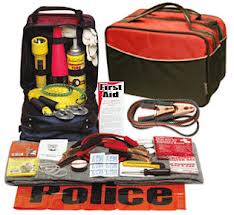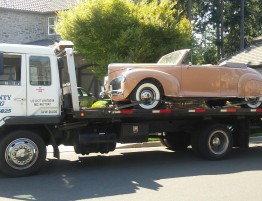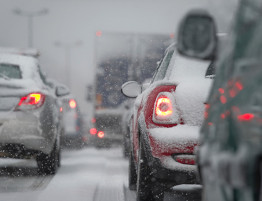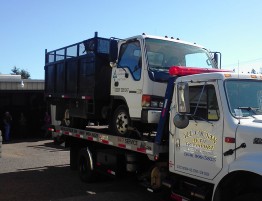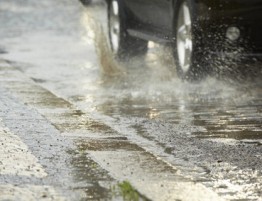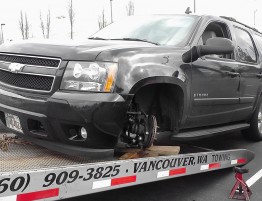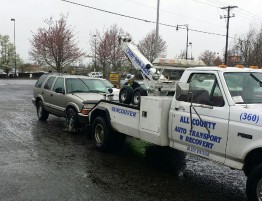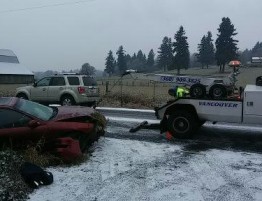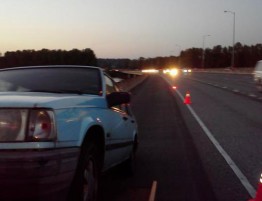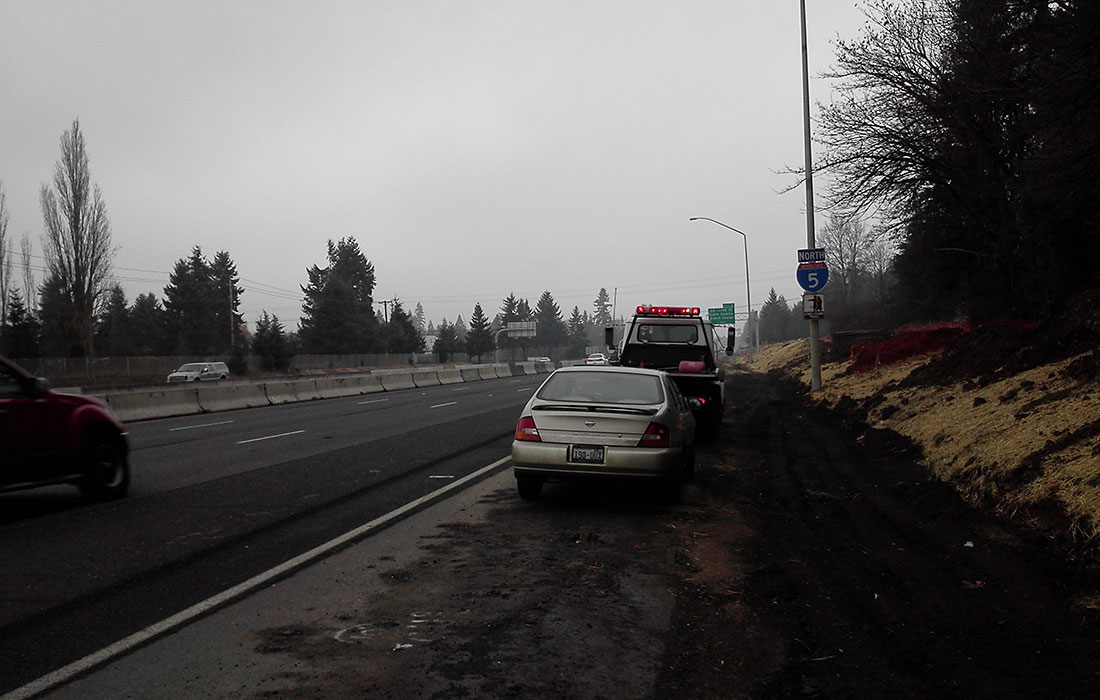
At All County Auto Towing in Vancouver, WA we want you to be prepared in an emergency. So here is a list of very important items everyone should have in their roadside emergency kit. An emergency roadside kit should be tailor made just for you, your vehicle and the area that you drive in. We hope that you never need to use it but we want you to have it there just in case.
A roadside emergency can happen at any time, whether your car is new or old. A range of problems can cause it, from a tire failure or mechanical breakdown to running out of fuel. At best, it’s an annoyance; at worst, it can compromise your safety. Being prepared with a basic emergency kit can increase your safety, reduce stress, and help you get back on the road faster.
Even if you have roadside-assistance coverage or an automobile-club membership with roadside assistance, you usually need access to a phone in order to contact them and you may have to wait on the side of the road for an hour or more before help arrives. That’s why we recommend that drivers carry certain items in their vehicle, even if it only gets used for everyday, around-town driving. This basic kit can be supplemented with additional items if you go on a long-distance trip or have to deal with winter weather conditions.
It’s also important to make periodic checks on the equipment to ensure it’s in working order—that the spare tire is properly inflated, batteries are not discharged, first-aid supplies are current, water is fresh, and food is dry. In addition, be familiar with how each tool works, from the cellular phone to the jack, before you need to use it in an emergency.
Basic Emergency Roadside Kit
This kit is intended to aid you in getting help, signaling your car’s presence to other motorists, and tackling simple challenges.
Cellular Phone
We don’t recommend that you talk on a cell phone while driving, but in an emergency, this can be the single most valuable component of your kit. Keep a car charger handy. This device plugs into the cigarette lighter or other power point in the car and charges the battery of your cell phone. When traveling, it’s best to leave your cell phone on. Emergency tip: If you have to dial 911, remember that your location and phone number aren’t always available to an emergency operator when calling from a cell phone. So give the operator your number and any information you have about your location. Ignore any “no service” messages on the phone and try the call anyway. If you have trouble connecting to 911 from inside a car, get out if possible and call from the side of the road. That may help you get a better signal.
First-Aid Kit
Choose one that allows you to treat a range of problems, from small cuts or burns to ones that require major bandaging. We also suggest you get familiar with how to use the kit before you need to.
Fire Extinguisher
A car fire can start from something as simple as a wiring short circuit or leaking oil. You should get away from a vehicle that’s on fire as quickly as possible. Still, for extra security it’s good to keep a fire extinguisher in the car that can be used in any emergency or to quickly dose a small flame that’s just begun. The quicker a fire can be put out, the less damage it will cause. Multipurpose dry-chemical fire extinguishers are available in a variety of sizes. We recommend carrying a compact unit that’s labeled 1A10BC or 2A10BC.
Warning Light, Hazard Triangle, Or Flares
If your vehicle is stuck on the side of the road, it’s vital that you give other motorists as much warning of its presence as possible, especially at night. Look for a battery-powered warning light that can be placed far from the vehicle. Reflective hazard triangles and flares are also effective and don’t need batteries.
Tire Gauge
This should be used on a monthly basis to check the inflation pressure in all four tires and the spare tire. Because the ambient temperature affects tire pressure, it’s also advisable to check the pressure after a significant change in temperature. See our latest Ratings and buying advice on tire pressure gauges.
Jack And Lug Wrench
Almost all vehicles come with these items for changing a tire. Refer to your owner’s manual on where they’re located in the vehicle and how to use them. Models that come with run-flat tires do not have a spare tire. Run-flat tires can be driven a limited number of miles with little or no air in them. They have very stiff sidewalls, which provide support when the tire is deflated. Learn more about the warning signs of imminent tire failure. It may also be a good idea to carry a cheater or breaker bar to slide over your lug wrench handle. Many tire shops torque the lug nuts using pneumatic impact guns that tighten lug nuts very well, but make it extremely difficult to remove with the factory supplied lug wrench.
Foam Tire Sealant Or A Portable Compressor And Plug Kit
For minor punctures, a foam tire sealant can get your vehicle back on the road quickly. Only use it in an emergency, however, as many tire shops will refuse to repair the tire because of the sticky residue these sealants leave inside it. Be sure to choose a sealant that’s labeled as non-flammable, and don’t consider this a permanent fix. A portable DC-powered air compressor can also be used to inflate a tire–and is especially handy for one that suffers from a slow leak. To fix a puncture, however, you need to have it professionally repaired. Do not attempt to fix a puncture in the sidewall, only punctures in the tread can be plugged. If your tire continues to leak but you can not find a puncture in the tire it may be the valve stem. You can check this by moving the valve stem around once you inflate the tire to see if air comes rushing out when pushed in a certain direction.
Spare Fuses
If you experience an electrical problem, your first check should be for a burned-out fuse. These are easy to check and replace by referring to your owner’s manual. Keep an assortment on hand of the proper type for your vehicle.
Jumper Cables Or A Portable Battery Booster
Jumper cables are easy to use as long as you have a second car available to provide a jump. Refer to your owner’s manual for instructions. A portable battery booster eliminates the need for a second car. There are a lot of places that sell cheap versions of these two items. A good set of 8′(eight foot) jumper/booster cables should run at least $40.00. The cheaper ones will require a long period of time allowing the battery to charge before it will actually start. You can check the quality of the cables by the number of copper wire strands in each cable. Cables with a lot of small copper wires will carry much more current than cables with less and larger copper wires. A good battery jump/booster box will cost at least $100.00 when on sale. Regular pricing for jump boxes worth buying range from $130.00 to $400.00 depending on the size of vehicle you drive. Diesel pickups will require more power than a gasoline pickup for instance. Also, make sure that the jump box you choose has a replaceable battery. If you can’t see yourself spending the money on a box or do not know why they are so expensive think about the cost of the last car battery you bought. That is pretty much what is in the box along with cables and other extras depending on the box you get. Some boxes come with internal air compressors, A/C and USB charging ports which come in handy out on the road.
Flashlight
This can be critical at night. Choose one that is bright and weatherproof. In addition, a flashlight with a magnet, flexible mounting system, or a stand will free up your hands for other tasks. Also, have extra batteries and a bulb available.
Gloves, Hand Cleaner, And Clean Rags
Even the simplest jobs can get your hands dirty. Having these on hand will help keep that dirt from getting on your clothes or your vehicle’s interior.
Auto-Club Card, Roadside-Assistance Number Or Local Towing Companies Info
If you belong to an auto club or roadside-assistance program, be sure you have the necessary information in your vehicle. Not all areas have contracted providers for every motor-club, including AAA. Although they do not like to, all motor clubs will reimburse you for if you pay out of pocket for you own tow. This is when the motor-club cannot find a provider, or the provider cannot get to you quickly enough. Not all local tow companies contract with motor-clubs for various reasons.
Disposable Flash Camera
Following an accident, this lets you record the condition of your vehicle and other vehicles for insurance purposes. A cell phone camera can also work.
$20 In Small Bills And Change
Keep this available for miscellaneous use. And resist dipping into it for a spontaneous ice cream cone on a hot day.
Pen And Pad Of Paper
This can come in handy for a range of uses, from leaving a note on the windshield should you have to leave your car to jotting down information after an accident.
Additional Items for Long-Distance Driving
For long trips, especially those through remote areas, add these items to your basic emergency kit.
Basic Tools
This includes a set of socket and open-end wrenches, a multi-tip screwdriver, and pliers. This should be enough to perform simple jobs such as changing a lightbulb, tightening battery cables, and so on. Even if you don’t know what to do, a Good Samaritan will still need something to work with.
Coolant Hose Repair Kit And Tape
A leaking coolant hose can sideline your vehicle quickly and possibly cause engine damage from overheating. Often, a leaking hose is a simple fix if you have the right items. They can be bought at any major auto-parts store.
Extra Clothes And Small Tarpaulin
Even if all you do is change a tire, these items can help keep your regular clothes clean.
Water And Nonperishable Emergency Food
Bring enough food and water to sustain you and any passengers for at least a meal, longer for remote areas or in extreme hot/cold regions.
CB Radio
If your route will take you into an area where cellular service is spotty, consider a portable or in-car CB radio.
GPS Navigation System
This is an optional item, but good to have when traveling to new places.
Additional Items for Winter Driving
For the cold, wet conditions of winter, you may need additional items in your emergency kit, especially if you travel in remote areas or in severe conditions.
Windshield Scraper
Good visibility is your most important safety item, but persistent snow and ice can build up quickly and make it hard to see. A long-handled, soft-bristled brush can also come in handy.
Tire Chains, Tow Strap and Come-Along
Familiarize yourself with how to put the chains on your vehicle’s tires or attach a tow strap before you need to do it in cold and possibly dark conditions. If you get stuck or slide of the road a bit a come-along and chain, cable or strap will come in handy to get you back on the road. Sometimes if there is quite a bit of tension on the cable, chain or strap put a folded blanket or jacket on the middle of the cable. This way, if it happens to break it shouldn’t snap back causing injury or damage.
Blanket And Winter Hat
If you run out of fuel or if your battery dies, the vehicle won’t be able to provide heat. A blanket and hat can help keep you warm if you have to wait for a long time in cold conditions.
Chemical Hand Warmers
These small, inexpensive packets are available at ski shops and sporting-goods stores.
Small Folding Shovel
If you get stuck in snow, this can be a vital tool. A folding camping-style shovel will require more digging effort than a longer-handled shovel, but is more convenient to store in the vehicle.
Bag Of Cat Litter
This can help provide some traction on an especially slick road surface.
All County Auto Towing in Vancouver Washington is here to lend a helping hand whenever possible. We hope that this helps you stay safe out on the road. If you are ever in need of service just give us a call day or night, we will be ready to assist you. Please Drive Safe and Enjoy the Road.
